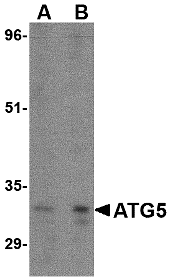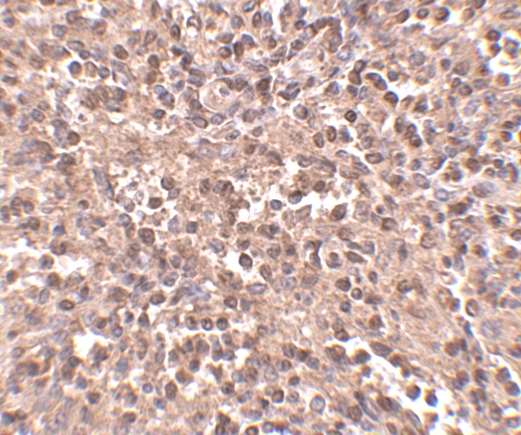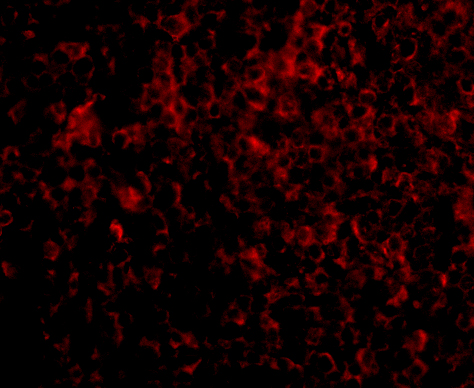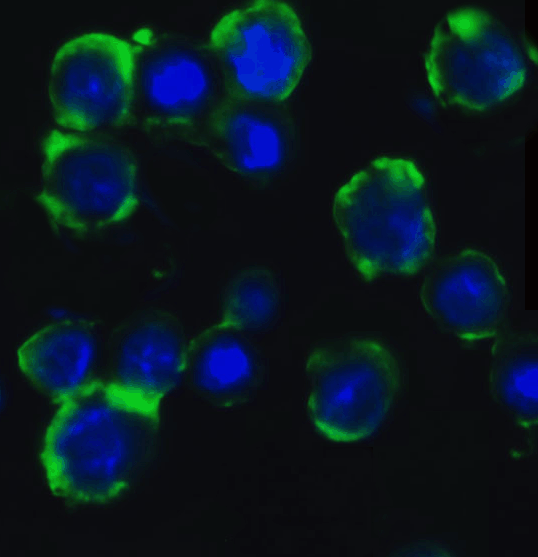ATG5 Antibody
| Code | Size | Price |
|---|
| PSI-4441-0.02mg | 0.02mg | £150.00 |
Quantity:
| PSI-4441-0.1mg | 0.1mg | £449.00 |
Quantity:
Prices exclude any Taxes / VAT
Overview
Host Type: Rabbit
Antibody Isotype: IgG
Antibody Clonality: Polyclonal
Regulatory Status: RUO
Applications:
- Enzyme-Linked Immunosorbent Assay (ELISA)
- Immunofluorescence (IF)
- Immunohistochemistry (IHC)
- Western Blot (WB)
Images
Documents
Further Information
Additional Names:
ATG5 Antibody: ASP, APG5, APG5L, hAPG5, APG5-LIKE
Application Note:
ATG5 antibody can be used for the detection of ATG5 by Western blot at 1 - 2 μg/mL. Antibody can also be used for immunohistochemistry starting at 2.5 μg/mL. For immunofluorescence start at 5 μg/mL.
Antibody validated: Western Blot in rat samples; Immunohistochemistry in human samples and Immunofluorescence in human samples. All other applications and species not yet tested.
Antibody validated: Western Blot in rat samples; Immunohistochemistry in human samples and Immunofluorescence in human samples. All other applications and species not yet tested.
Background:
ATG5 Antibody: Autophagy, the process of bulk degradation of cellular proteins through an autophagosomic-lysosomal pathway is important for normal growth control and may be defective in tumor cells. It is involved in the preservation of cellular nutrients under starvation conditions as well as the normal turnover of cytosolic components. This process is negatively regulated by TOR (Target of rapamycin) through phosphorylation of autophagy protein APG1. ATG5, another member of the autophagy protein family, forms a conjugate with ATG12; this conjugate has a ubiquitin-protein ligase (E3)-like activity for protein lipidation in autophagy. This conjugate also associates with innate immune response proteins such as RIG-I and VISA (also known as IPS-1), inhibiting type I interferon production and permitting viral replication in host cells.
Background References:
- Gozuacik and Kimchi. Oncogene 2004; 23:2891-906.
- Kisen et al. Carcinogenesis 1993; 14:2501-5.
- Kamada et al. J. Cell. Biol. 2000; 150:1507-13.
- Hanada et al. J. Biol. Chem.2007; 282:37298-302.
Buffer:
ATG5 Antibody is supplied in PBS containing 0.02% sodium azide.
Concentration:
1 mg/mL
Conjugate:
Unconjugated
DISCLAIMER:
Optimal dilutions/concentrations should be determined by the end user. The information provided is a guideline for product use. This product is for research use only.
Homology:
Predicted species reactivity based on immunogen sequence: Bovine: (94%), Pig: (94%)
Immunogen:
ATG5 antibody was raised against a 16 amino acid synthetic peptide from near the amino terminus of human ATG5.
The immunogen is located within the first 50 amino acids of ATG5.
The immunogen is located within the first 50 amino acids of ATG5.
NCBI Gene ID #:
9474
NCBI Official Name:
ATG5 autophagy related 5 homolog (S. cerevisiae)
NCBI Official Symbol:
ATG5
NCBI Organism:
Homo sapiens
Physical State:
Liquid
Protein Accession #:
EAW48415
Protein GI Number:
119568800
Purification:
ATG5 Antibody is affinity chromatography purified via peptide column.
Research Area:
Autophagy
SPECIFICITY:
Three isoforms of ATG5 are known to exist; this ATG5 antibody will only detect the longest isoform.
Swissprot #:
A9UGY9
User NOte:
Optimal dilutions for each application to be determined by the researcher.
Related Products
| Product Name | Product Code | Supplier | ATG5 Peptide | PSI-4441P | ProSci | Summary Details | |||||||||||||||||||||||||||||||||||||||||||||||||||||||||||||||||||||||||||||||||||||||||||||
|---|---|---|---|---|---|---|---|---|---|---|---|---|---|---|---|---|---|---|---|---|---|---|---|---|---|---|---|---|---|---|---|---|---|---|---|---|---|---|---|---|---|---|---|---|---|---|---|---|---|---|---|---|---|---|---|---|---|---|---|---|---|---|---|---|---|---|---|---|---|---|---|---|---|---|---|---|---|---|---|---|---|---|---|---|---|---|---|---|---|---|---|---|---|---|---|---|---|---|---|






